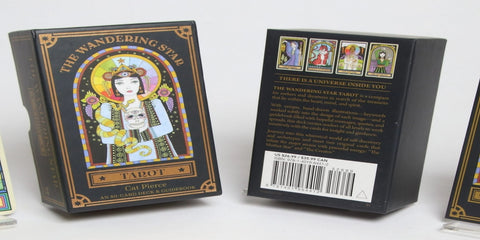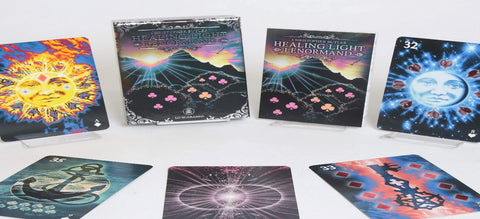
A Beginner's Guide to Tarot and Oracle Cards: History, Tips, and Deck Recommendations
For centuries, mystics and occultists have used tarot cards as tools for divination, meditation, and unlocking insights into the past, present and future. Originating in 15th-century Europe, tarot has evolved over generations while retaining its essential symbolic power. Today, these 78-card decks continue to fascinate spiritual seekers, artists, psychologists and anyone seeking to explore the subconscious mind.
In recent years, a new form of divination has emerged in the form of oracle cards. Typically with fewer cards and more modern designs than classic tarot, these decks allow you to tap into mystical energies and channel guidance, whether tarot or oracle. Working with these cards requires an open mind and patience to interpret the meanings.
In this beginner's guide, we'll explore the history of tarot, provide tips to interpreting and selecting your first deck, and recommend some easy-to-use beginner tarot and oracle card decks available in our shop. Discover the powerful world of card divination!
A Brief History of Tarot
While tarot origins are shrouded in mystery, the earliest decks likely originated in 15th-century Italy and France. The Visconti-Sforza deck, created around 1450 in Milan, is the oldest surviving tarot deck. European nobility likely used These lavishly decorated cards for playing card games. The symbolic imagery of these early decks later evolved into the basis for the Major and Minor Arcana cards.
Over the next centuries, tarot transformed from simple playing cards into tools for esoteric arts. In 1781, Antoine Court de Gébelin, a French clergyman and Freemason, published a speculative work connecting the tarot symbols to ancient Egyptian mysticism. Other occult philosophers expanded on this theory, and tarot became intertwined with Kabbalah, astrology, numerology and other mystical disciplines.

1909 Arthur Edward Waite and illustrator Pamela Colman Smith designed the Rider-Waite tarot deck. This hugely popular 78-card deck introduced imagery like the Fool, the Lovers, the Hermit and more now synonymous with tarot—the Rider-Waite deck standardized readings and meanings for future generations of tarot readers.
Tips for Beginners on Reading and Interpreting Tarot Cards
For newcomers, interpreting tarot card spreads can seem daunting. How do you make sense of arcane symbols and know what the cards intend to convey? Start with these basic tips:
- Refer to guidebooks - For any deck; its guidebook offers essential details about the imagery and meanings in the cards. Keep the guidebook handy as you learn.
- Start with simple 3-5 card spreads - Limit yourself to a few cards while learning. The popular 3-card past/present/future spread is very beginner friendly.
- Combine intuition with card meanings - While starting out, refer to the guidebook's interpretation of each card. Also, tune into your intuitive hunches about the message.
- Keep tarot journals - Record card spreads and readings along with the circumstances, your interpretations, and what transpired for reflection.
- Learn the "card families" - Cups are emotions, Pentacles are resources, and Wands are actions. Knowing the suits aids interpretation.
- Spend time with the Major Arcana - The 22 cards like The Fool, The Lovers, and The World offer deep symbolic meaning to tap into.
- See reversals as nuance - Don't fear reversed cards! They simply add nuance so Death reversed signifies resisting transition, not literal death.
With regular use, tarot cards will begin to unveil their secrets. Keep an open mind, build your interpretation skills slowly and let the cards guide you.
Choosing Your First Beginner-Friendly Tarot Deck
The available decks today can be overwhelming, running the gamut from traditional Rider-Waite style to fantastical modern designs. For your first deck, stick to classic imagery and straightforward interpretations. Here are beginner-friendly tarot deck recommendations:
Rider-Waite Tarot Deck - The Rider-Waite deck birthed modern tarot, making it the perfect starting point to learn the "language" of tarot. The traditional imagery and symbolism allow you to build interpretation skills that apply to many decks.
Modern Witch Tarot – Another tarot deck merging tarot with witchcraft themes. The clean art style and thoughtful guidebook by illustrator Lisa Sterle make this an ideal starter deck.

Exploring the World of Oracle Cards
While less well-known than tarot, oracle cards offer a more flexible, creative way to channel wisdom from the universe. Typically with fewer cards and more modern designs than tarot, oracle decks connect you to spiritual energies relevant to your life right now. Think of oracles as tarot's hipper, more free-spirited cousin!
Oracles aren't burdened by tarot's fixed structure of suits and Trump cards. The cards in an oracle deck share a common motif like angels, faeries, goddesses or Native American traditions, but without adhering to rigid rules. Simply put, oracles let spiritual seekers tap into mystical energies in a more accessible and playful manner.
Great Beginner Friendly Oracle Decks
Oracle cards make an ideal entry point for mystic exploration because of their flexibility. Here are recommended starter oracle decks:
Moonology Oracle Cards - Harness the moon's phases and energies for intuitive living via this popular, aesthetically pleasing card set by astrologer Yasmin Boland.
Earth Magic Oracle Cards - Gorgeous natural imagery and American folk magic themes make this perfect for those drawn to nature-based spirituality.
Have Fun Exploring and Interpreting!
Tarot and oracle cards open doorways to inner wisdom, self-understanding and spiritual energies that fascinate and resonate with many seekers. By starting with beginner-friendly decks and learning the basic skills slowly and intentionally, the magic of card divination will begin to unfold before you. Allow cards by respected authors and artists to guide you.
Most of all, have fun as you explore tarot and oracle cards! Form your own relationships with the imagery and symbolism. While learning established structures and meanings from quality guidebooks, also tune into your own intuition. Beautifully illustrated cards connecting you to energies beyond the mundane world await.

Leave a comment